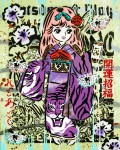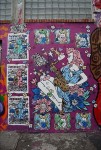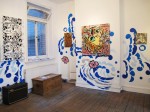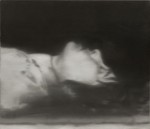Eduardo Recife is a Brazilian designer of many talents. He’s an illustrator, graphic designer, and typographer who has worked with an amazing range of clients including the New York Times, Entertainment Weekly, Showtime, et cetera, et cetera. His quirky, grunged-up collage-based illustrations are simply captivating.
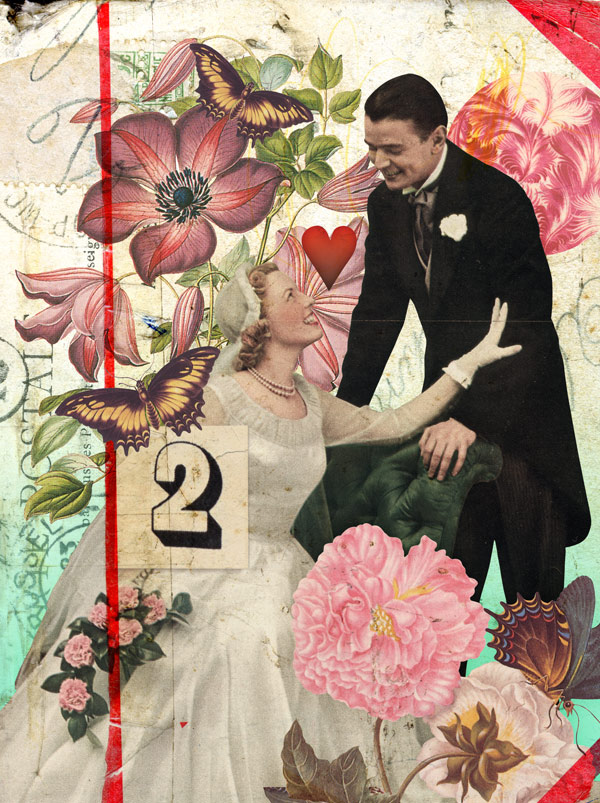
Eduardo Recife – New York Times, 2011
Not only does he have a great roster of clients, but last year he won a Cannes Gold Lion for book illustration. That’s pretty sweet. I’m only showing the cover here but you can see the rest of the book illustrations for this project on his commercial portfolio site.
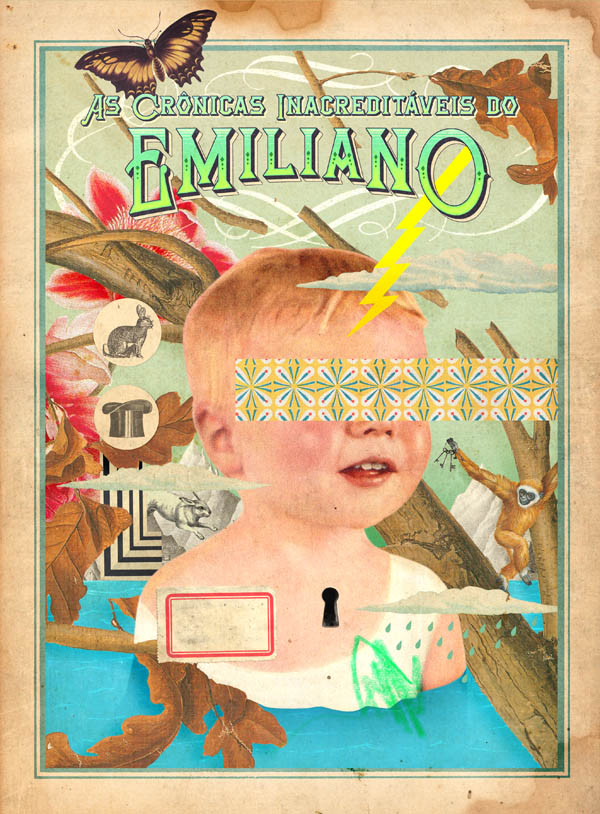
Eduardo Recife – Cannes Lion, 2011
Recife’s personal work is a lot of fun, too. If you check out his personal site you can see a wide range of illustrations from over the years, download free fonts (I am a big fan of Selfish and Porcelain, both designed in 2001), and basically be awed by the talent dripping off your computer screen. Okay, that sounds kind of gross so let’s just stick with “awed by the talent”.
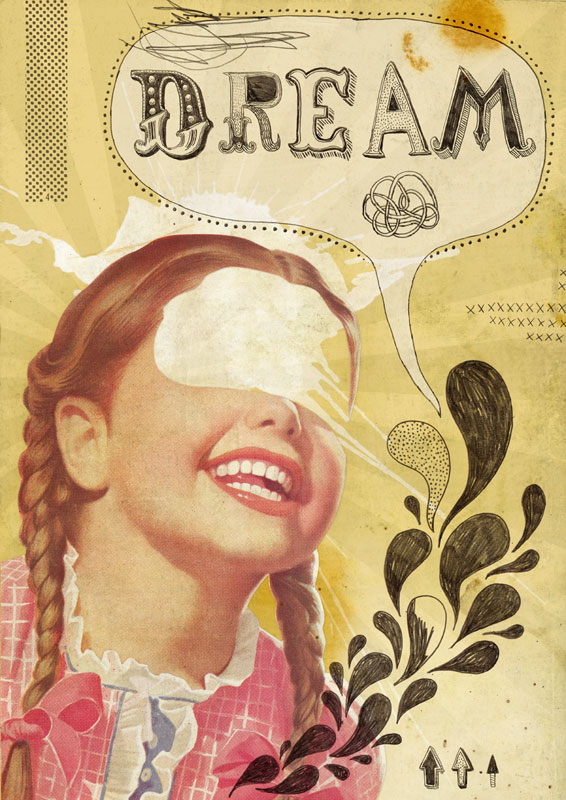
Eduardo Recife – Dream
If you really, really like his work (and why wouldn’t you?) there are giclée prints available via inPRNT.

Eduardo Recife – Hope
Vandalog has an interesting discussion going on about the role of women artists in the street art scene, and how they are often under-represented. While this is largely true, the question of why fewer women get involved with street art is a hard one to answer. It’s impossible to deny that there are, however, some truly stellar woman artists out there, such as Lady Aiko (disclaimer: some content on Lady Aiko’s site is NSFW, including her landing page).
The high-visibility corner of Houston Street and Bowery has been one of New York’s most exclusive curated walls since 2008. Os Gemeos, JR, Shepard Fairey and RETNA are just a few of the artists who have painted or installed artwork there, and this month, Aiko becomes the first female to paint the coveted spot.
– Vandalog
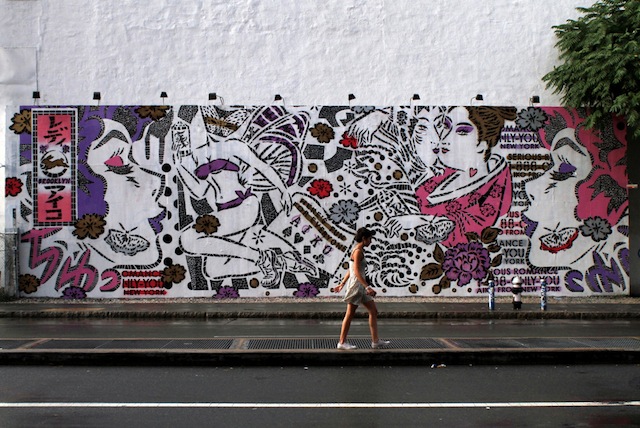
Lady Aiko Houston-Bowery mural – photo by Luna Park (via vandalog)
Born in Japan and a resident of Brooklyn, Lady Aiko has been a strong figure in street art for some time, having been a co-founder of the FAILE collective.
McNeil and Miller met during their youth in Arizona. Separated in 1996 when Miller remained in art school in Minneapolis and McNeil continued to New York, by the end of the decade, the duo reconnected and, with the addition of then filmmaker Aiko Nakagawa (b. 1975, Tokyo, JP), “A Life” was conceived. By early 2000, the trio contributed to the emergence of a nascent,street art culture by circulating their screenprinted and painted work on city streets, usually using the subversive processes of wheatpasting (flyposting) and stenciling. During the ensuing years McNeil, Miller, and Nakagawa solidified both their omnivorous style of pop-cultural collage, and changed their name to FAILE (an anagram of A Life). Nakagawa left FAILE in 2006, gaining success in her own right as Lady Aiko…
– Wikipedia
Lady Aiko has also collaborated with Takashi Murakami and Banksy. Her work takes on a more stencil-based approach as compared with her earlier work with FAILE, and she works with pattern, space and surface in a very compelling way.
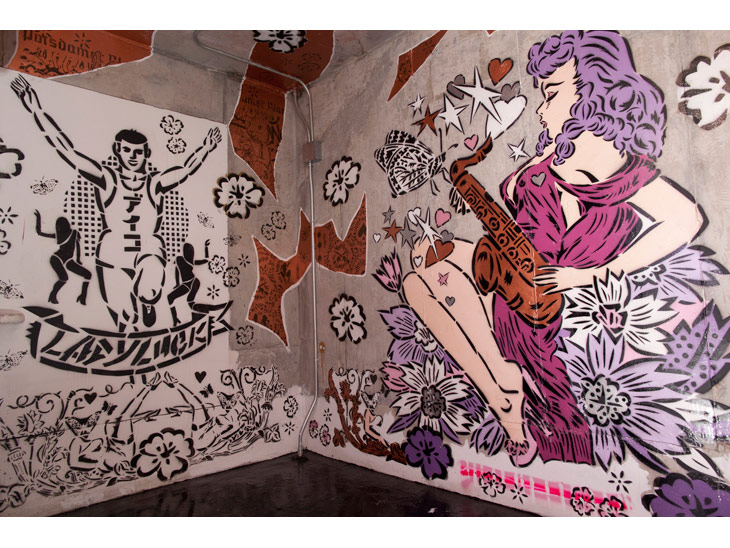
The Standard NY, 2010. Hollywood, 2010. DTLA, 2012.
- Lady Aiko Houston-Bowery mural – photo by Luna Park (via vandalog)
- The Standard NY, 2010. Hollywood, 2010. DTLA, 2012.
You can see more of Lady Aiko’s work on her website (some work NSFW). There’s also a great ongoing discussion of her work on the Artchival discussion boards (some work NSFW)
Well, this is weird.
Banksy needs no introduction, as probably the most sought-after street artist in the world by collectors and graffiti afficianadoes alike. When one of his pieces appears on a wall, it is generally preserved as a tourist attraction. Anyhow, as you may have heard, London is hosting the Olympics. In light of this, various officials have stated that any Olympics-themed street art or graffiti will be removed – according to vandalog anyhow. But, oh noes, Banksy has created Olympic-themed graffiti! What to do? Do the authorities wipe away the work of arguably the most famous street artist in the world, eradicating culture for the sake of crass commercialism, or do they leave it, making a mockery of their own laws? Oh, the dilemma.

Various newsy types have been going on and on about this latest development including the BBC & the Mirror UK. For what it’s worth, the Beeb states that:
Olympic organisers Locog said there were not any official guidelines on removing graffiti.
Street artists say their freedom of expression is being curtailed as Olympic-themed artwork is quickly being removed.

A spokeswoman for Ealing Council said …
“This is in line with our policy to remove all reported graffiti as soon as possible, unless we have been made aware in advance that it is there with the consent of the building owner and it is not offensive,” she added…
“It’s nice that the whole country is getting a facelift. Graffiti makes an area look neglected and unloved and it impacts how people feel about an area,” she said.
“We have a million extra people coming here so we want them to see the area looking its best.”
Yeah, well. Beauty is in the eye of the beholder, I suppose. Whatever comes of all this kerfuffle it’s interesting to see that graffiti is making the news for political reasons. As Banksy once said (harsh language warning)…
“People are taking the piss out of you everyday. They butt into your life, take a cheap shot at you and then disappear. They leer at you from tall buildings and make you feel small. They make flippant comments from buses that imply you’re not sexy enough and that all the fun is happening somewhere else. They are on TV making your girlfriend feel inadequate. They have access to the most sophisticated technology the world has ever seen and they bully you with it. They are The Advertisers and they are laughing at you.
“You, however, are forbidden to touch them. Trademarks, intellectual property rights and copyright law mean advertisers can say what they like wherever they like with total impunity.
“Fuck that. Any advert in a public space that gives you no choice whether you see it or not is yours. It’s yours to take, re-arrange and re-use. You can do whatever you like with it. Asking for permission is like asking to keep a rock someone just threw at your head.
“You owe the companies nothing. Less than nothing, you especially don’t owe them any courtesy. They owe you. They have re-arranged the world to put themselves in front of you. They never asked for your permission, don’t even start asking for theirs.”
More of Banksy’s work can be seen on his website.
René Gruau was one of the most influential fashion illustrators of the 20th century. Gruau was born Renato Zavagli Ricciardelli delle Caminate in Rimini, on Italy’s Adriatic coast. When Gruau was 3, his father (an Italian count) and mother (a French aristocrat) separated. Gruau moved with his mother to Paris, where he was raised with her name. Unfortunately they fell on hard times, and in an effort to help support his mother, Gruau (fortunately) took up commercial art.
Though it’s hard to believe now, Gruau’s drawing style was not particularly popular when he started out – a finer, more detailed style was in demand. As this was before the advent of photography, however, there was a lot more work for illustrators so Gruau did find plenty of work and was internationally published, just not famous …yet.
(He preferred) the heavier brushed ink or charcoal outlines and restricted, powerful palette of those pre-1900 Parisian artists, especially Toulouse-Lautrec, who produced arresting calligraphic posters. Not until the 1930s, when Gruau began to sketch for Parisian newspapers and magazines, including Le Figaro and Fémina, did the general graphic mood veer towards his taste, after Carl Erickson introduced a thicker line and oilpaint colour to the glossies. Gruau delineated the clothes of Balmain, Lanvin, Schiaparelli and his favourite, Balenciaga; and befriended Dior, then also an illustrator.
– from Gruau’s obituary in the Guardian UK
When he started working with Christian Dior, however, Gruau firmly established himself as one of the most important figures not only in illustration, but in fashion as a whole.
Gruau worked for many patrons including Balmain, Givenchy, Schiaparelli, Jacques Fath and Edward Molyneux, and also for suppliers of top-quality textiles, cars and brandy. He did ballet sets and costumes. But arguably it was his creative collaboration with Christian Dior and the House of Dior that stamped his reputation. Beginning with Dior’s New Look in 1947, Gruau’s connection with the couture house continued well after Dior’s death in 1957, until the late 1990s.
Whether you are interested in fashion or not, it is easy to be captivated by Gruau’s bold brushwork and easy, graceful line. From advertising to fashion plates, Gruau’s versatility and expressiveness make his work timelessly enchanting.
Explore the official René Gruau site for more.
Gerhard Richter is a German artist, best known as a painter, particularly oil on canvas. He’s been one of my favourites for years, and I’m not alone: at auction his work achieves higher prices than any other living artist, approximately 200 million USD last year alone. I’m not writing about Richter to go on about what a big deal he is, though, I’m writing about his Baader-Meinhof Gang paintings. In 1988 he created a series of 15 paintings entitled “October 18, 1977”, about the German terrorist group, the Baader-Meinhof Gang (officially the RAF or Rote Armee Fraktion, “Red Army Faction”).
The Red Army Faction existed from 1970 to 1998, committing numerous operations, especially in late 1977, which led to a national crisis that became known as “German Autumn“. It was held responsible for thirty-four deaths, including many secondary targets, such as chauffeurs and bodyguards, and many injuries in its almost thirty years of activity.
– Wikipedia
In many ways it was this series of paintings that made Richter internationally famous. It also generated a pile of controversy from both the political left and the right in Germany – the RAF were seen as antiheroes by many on the left, in many ways a radicalized attack upon the right-wing politics of Germany that were still associated with the legacy of Naziism, not just ideologically but in fact as many important political figures in Germany tried to whitewash or hide their Nazi pasts. The right viewed them simply as terrorists.
The leading members of the first generation of the (RAF) were arrested in 1972. Their terrorist activities, their unparalleled pursuit by the police force and their joint suicides provoked heated discussion in Germany for a long time.
The title of the series, October 18, 1977, refers to the date on which Gudrun Ensslin, Andreas Baader and Jan-Carl Raspe were found dead in their cells in Stuttgart-Stammheim prison. . …The unveiling of the paintings in 1989 caused a stir that shows that the matter was not resolved in the eyes of the German general public either.
– From Gerhard Richter’s official website
Richter’s own political positioning was attacked even though he was painting entirely from documentary photographs, as he did not openly identify himself as either left or right wing. This made the left suspect him of being a right-winger appropriating “their” figures, and the right wing suspect the paintings of being too sympathetic to the RAF.
(Richter) once wrote: ”Because Marxist intellectuals refuse to own up to their own disillusionment, it transforms itself into a craving for revenge. And so they turn their own ideological bankruptcy into the utter bankruptcy of the whole world — mainly the capitalist world, of course, which they vilify and poison in their hatred and despair.”
In 1988, he painted a series of 15 works titled ”October 18, 1977.” It shocked Germans. The series was based on photographs of the Baader-Meinhof group, which called itself the Red Army Faction. Andreas Baader was a street hustler; Ulrike Meinhof was a radical journalist and former pacifist. With others — Gudrun Ensslin, Holger Meins, Jan-Carl Raspe and Irmgard Moller, among them — they staged a string of robberies, shootings and bombings of American Army bases that ended with the arrest of those six in 1972. A five-year struggle ensued during which other group members, allied with various European and Middle East terrorists, kidnapped hostages and occupied the West German Embassy in Stockholm to extort their release. The jailed members staged hunger strikes. Meins died. Meinhof was found hanged in her cell. The police called it suicide.
…”I was afraid more of the reaction on the left than the right,” he says. ”It was still very dangerous to deal with this subject in Germany. There was fear that the museum where I showed them might be bombed. All my friends were on the left, but I was not. They said: ‘Someone with the right mentality could do this, but not Richter — he is too bourgeois. He steals Baader-Meinhof away from us.’ To me, they were part of the problem. I was standing outside watching how people, on both sides, ignored the truth because of their beliefs, beliefs that made them crazy. That was the point of the pictures.”
- Tote 1 (Dead 1) 62 cm x 67 cm
- Tote 2 (Dead 2) 62 cm x 62 cm
- Tote 3 (Dead 3) 35 cm x 40 cm
- Erhängte (Hanged) 200 cm x 140 cm
- Erschossener 1 (Man Shot Down 1) 100 cm x 140 cm
- Erschossener 2 (Man Shot Down 2) 100 cm x 140 cm
- Zelle (Cell) 200 cm x 140 cm
- Gegenüberstellung 1 (Confrontation 1) 112 cm x 102 cm
- Gegenüberstellung 2 (Confrontation 2) 112 cm x 102 cm
- Gegenüberstellung 3 (Confrontation 3) 112 cm x 102 cm
- Jugendbildnis (Youth Portrait) 67 cm x 62 cm
- Plattenspieler (Record Player) 62 cm x 83 cm
- Beerdigung (Funeral) 200 cm x 320 cm
- Festnahme 1 (Arrest 1) 92 cm x 126 cm
- Festnahme 2 (Arrest 2) 92 cm x 126 cm
Full notes on each painting in the series can be seen on Gerhard Richter’s official site.
The paintings were created in different formats, but the consistent reduction to tones of grey underlines their conception as a series. The grisaille palette refers also to newspapers of that time, which were mostly printed in black and white. All paintings except Youth Portrait are based on documentary photographs, including press photographs and pictures taken by the police. … In addition to the actual source photographs, he collected more than 100 pictures related to the RAF in these two albums.
Due to the extensive and continued presence of the RAF in the media it can be assumed that the audience who saw the works around the time they were created would easily have made a connection between Richter’s paintings and the activities of the RAF – despite the blurred imagery and neutral titles. As with this series of work, the artist often refers to images that have entered the collective memory, ensuring a renewed remembrance of past events and inviting new perspectives on them.
– from the official Gerhard Richter website
Richter has been criticised by some in the art world for making his series too time-and-place specific unlike a truly “timeless” work of art like, say, the Mona Lisa, rendering them essentially unknowable to anyone except Germans who had lived through “German Autumn” of 1977. Certainly this is true of just looking at the paintings and not reading the extensive explanatory material available when the paintings are exhibited. Most people won’t recognize the significance of a bookshelf, not knowing that this was based on a famous-at-the-time photo of Baader’s bookshelf which was significant to how the public viewed him. Most people won’t know that “Hanged” is from a photo of Ulrike Meinhof, one of the RAF founders who was reported as having committed suicide – but every German in 1988 would recognize it. That said, I’m pretty sure most people walking through any art museum don’t get the historical context of 90% of what they’re seeing, and unless they have studied art history, they probably miss out one the vast majority of even the artistic conventions and relevance of the work they are viewing.
I suppose that in many ways this comes down to a question of whether the meaning of work resides in the artist’s intent or in the viewer’s experience of the art. Certainly in a series so obviously laden with intended meaning it could be frustrating to be confronted by the lack of context the paintings themselves bring to the table – but to a very large extent, I think that’s the point of this series – there is something essentially unknowable about even famous events in current history. I don’t think it’s accidental that Richter blurs his work like out-of-focus photographs – the reference to the unreliability of evidence forces the viewer to consider the inaccuracies of reportage and what it is to “know” and how much is ever really “known”. On a more physical level, to bring the work into focus you are forced to step further away from it. That’s a pretty intense metaphor by itself.
“October 18, 1977” is part of the permanent collection of MoMA in NYC.




